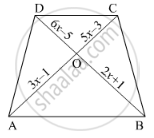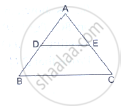Advertisements
Advertisements
प्रश्न
If ∆ABC and ∆DEF are two triangles such that\[\frac{AB}{DE} = \frac{BC}{EF} = \frac{CA}{FD} = \frac{3}{4}\], then write Area (∆ABC) : Area (∆DEF)
उत्तर
GIVEN: ΔABC and ΔDEF are two triangles such that .
TO FIND: Area (ABC) : Area (DEF)
We know that two triangles are similar if their corresponding sides are proportional.
Here, ΔABC and ΔDEF are similar triangles because their corresponding sides are given proportional, i.e. \[\frac{AB}{DE} = \frac{BC}{EF} = \frac{CA}{FD} = \frac{3}{4}\]
Since the ratio of the areas of two similar triangle is equal to the ratio of the squares of their corresponding sides.
`⇒ (Area(Δ ABC))/(Area(Δ DEF))=9/12`
APPEARS IN
संबंधित प्रश्न
In the below figure, If AB || CD, find the value of x.

D and E are points on the sides AB and AC respectively of a ΔABC. In each of the following cases, determine whether DE║BC or not.
AB = 10.8cm, AD = 6.3cm, AC = 9.6cm and EC = 4cm.

In each of the figures [(i)-(iv)] given below, a line segment is drawn parallel to one side of the triangle and the lengths of certain line-segment are marked. Find the value of x in each of the following :

In ∆PQR, M and N are points on sides PQ and PR respectively such that PM = 15 cm and NR = 8 cm. If PQ = 25 cm and PR = 20 cm state whether MN || QR.
In ∆ABC, ∠ABC = 135°. Prove that AC2 = AB2 + BC2 + 4 ar (∆ABC)
State AAA similarity criterion.
Sides of two similar triangles are in the ratio 4 : 9. Areas of these triangles are in the ratio.
A man goes 24 m due west and then 7 m due north. How far is he from the starting point?
In an equilateral triangle ABC if AD ⊥ BC, then
∆ABC is a right triangle right-angled at A and AD ⊥ BC. Then, \[\frac{BD}{DC} =\]
